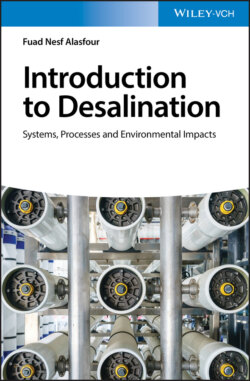Читать книгу Introduction to Desalination - Fuad Nesf Alasfour - Страница 2
Table of Contents
Оглавление1 Cover
2 Preface
3 1 Introduction 1.1 What Is Desalination? 1.2 Aims of Desalination Processes 1.3 Desalination Processes 1.4 Desalination Technologies 1.5 Which Desalination System Is the Best? 1.6 Thermo‐Physical Properties of Water References A. Review Questions
4 Part I: Thermal Desalination Systems 2 Multi‐effect Evaporator (MEE) 2.1 Introduction 2.2 Vaporization 2.3 MEE Processes 2.4 MEE Configurations 2.5 Mathematical Modeling Algorithm for Thermal Systems 2.6 MEE Mathematical Model 2.7 MEE Integrated Auxiliary Devices 2.8 Characteristics of MEE Desalination Systems 2.9 MEE Energy Consumption and Cost References 3 Multi‐stage Flashing (MSF) 3.1 Flashing Stage 3.2 MSF Once‐Through Configuration MSF–OT 3.3 MSF–Brine Recirculation (MSF–BR) 3.4 MSF with Brine Mixer (MSF–BM) 3.5 Material of Construction References A. Review Questions B. Problems C. Essay, Design and Open‐Ended Problems 4 Vapor Compression: Thermal Vapor Compression (TVC), Mechanical Vapor Compression (MVC), and Mechanical Vapor Recompression (MVR) 4.1 Thermal Vapor Compression (TVC) 4.2 TVC Mathematical Modeling 4.3 Mechanical Vapor Compression (MVC) 4.4 SEE–MVC Mathematical Modeling 4.5 Mechanical Vapor Recompression (MVR) 4.6 Characteristics of VC Desalination System References
5 Part II: Membrane Desalination Systems 5 Pressure Gradient Driving Force: Reverse Osmosis (RO), Nanofiltration (NF), Ultrafiltration (UF), Microfiltration (MF) 5.1 Semipermeable Membrane: Properties and Modules 5.2 Membrane Modules (Configurations) 5.3 Natural Osmosis Phenomenon 5.4 Reverse Osmosis (RO) 5.5 Membrane Performance 5.6 RO System Components 5.7 RO Advantages and Disadvantages 5.8 RO Performance Using Software 5.9 RO Mathematical Model 5.10 Energy Recovery Device (ERD) 5.11 MF, UF, and NF Membranes: Materials and Applications References A. Review Questions B. Problems C. Essay, Design and Open‐Ended Problems 6 Electrical Potential Driving Force: Electrodialysis (ED), Electrodialysis Reversed (EDR) 6.1 Electrodialysis 6.2 Electrodialysis Principle 6.3 Conservation of Ionic Mass 6.4 ED Mathematical Modeling 6.5 ED Characteristics 6.6 Advantages and Disadvantages of ED 6.7 Electrodialysis Reversed (EDR) References A. Review Questions B. Problems C. Essay, Design and Open‐Ended Problems 7 Temperature Gradient Driving Force: Membrane Distillation (MD) 7.1 MD Processes and Configurations 7.2 MD Advantages and Disadvantages 7.3 Characteristics of Hydrophobic Membranes 7.4 Heat and Mass Transfer Models for DCMD References 8 Concentration Gradient Driving Force: Natural Osmosis, Forward Osmosis (FO), Pervaporation (PV), Dialysis 8.1 Forward Osmosis (FO) 8.2 Pervaporation (PV) 8.3 Dialysis 8.4 Summary: Membrane Desalination Systems References
6 Part III: Nonconventional Desalination Systems 9 Renewable Energy and Desalination: Solar, Wind, Geothermal 9.1 Solar Energy 9.2 Calculation of Solar Radiation on Inclined Surface 9.3 Wind Energy 9.4 Geothermal Energy 9.5 Geothermal Well Performance 9.6 Advantages of Geothermal Energy References Questions and Problems 10 Hybrid Desalination System 10.1 Case I: Cogeneration–MSF–RO Hybrid Desalination Systems 10.2 Case II: Hybrid SEF–Geothermal Desalination System 10.3 Case III: Hybrid MEE–Solar Desalination System (Adapted from [4]) 10.4 Case IV: Hybrid MD–RO Desalination System (Adapted from [5]) 10.5 Case V: Hybrid Humidification–Dehumidification Desalination System [6] References Essay, Design, and Open‐Ended Problems
7 Appendix A: Appendix AThermo‐Physical Properties of SeawaterThermo‐Physical Properties of Seawater
8 Index
